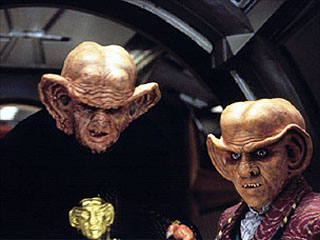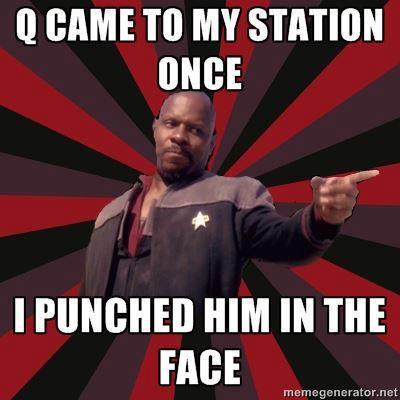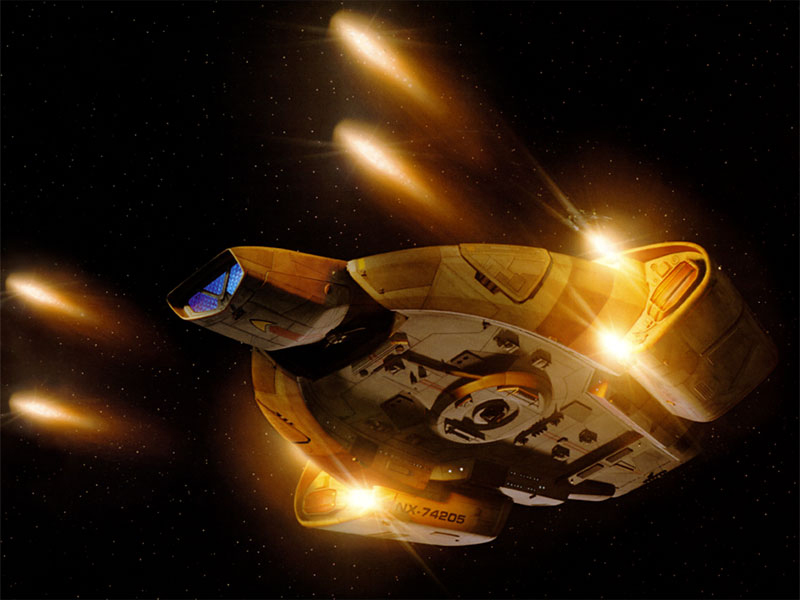I come not to bury Trek, brothers and sisters. I come to praise Trek, especially Trek Most Glorious, Deep Space Nine. Ye naysayers and nanny-boggins may decry me a heretic, but Deep Space Nine has proven itself the worthiest of claimants to Trek’s golden throne.
In the beginning, we had the Original Series in all its glory. Kirk, Spock, Bones and the Enterprise crew blazed the trail for us all; we saw how we could Boldly Go to a better future. Classic Trek is full of promise and gee-whiz optimism for the future. And it’s corny as hell. The Next Generation warped in decades later and filled a void we hardly knew existed. And yes, it was pretty corny, too. Hide your rage, TNG fans. Your show was fun, but in revisiting the endeavors of the Enterprise D, I have determined that half of your offerings were not so great. You had your epic moments, but there was a lot of labored viewing to get to them. Voyager, you are an abomination, and should take Enterprise back to the kiddy table. We’ll take you more seriously when you have something worth contributing.
Now that I have pissed off half of Trekdom, I had best make my case. Here, for your perusal, are the Ten Reasons why DS9 is the Best of Trek…
#10. Quark (and the Ferengi in general)
When the Ferengi were introduced on the Next Generation, they were supposed to be the new big bad that would shake the Federation to its core. They wore furs. They leered at women. They had scary laser whips… and they sucked. They continued to suck every time they ever showed up on TNG. It was like a Roddenberrian Wormhole of Epic Suckitude opened up whenever they appeared. Luckily, someone had their eye on the suck-o-meter, and shoe-horned them out of the way in favor of Klingons, Romulans, and the Borg.
Deep Space Nine changed that. The Ferengi were brought back into the spotlight through the lecherous lens of Quark, owner of Quarks bar, which served as the social hub of the space station. Quark ran pretty much every shady deal there was on the station, and was a giant pain in the gelatin for Odo, the station Constable. Quark also had a conscience, which lead to some great conflicts with the Ferengi government.
Oh, what a government it was. The Ferengi had styled their entire society off of the Rules of Acquisition, a complex set of guidelines to help an enterprising Ferengi screw over anyone he wanted to do business with. The Ferengi people were governed by the Grand Nagus, brilliantly played by Wallace Shawn. By the time DS9 wrapped it’s seventh season, the Ferengi had evolved from unintentionally annoying villains to intentionally annoying movers and shakers.
#9. The Gamma Quadrant
Deep Space Nine guarded the Alpha Quadrant entrance to the Bajoran Wormhole, which allowed quick trade access to the far-distant Gamma Quadrant. By allowing the DS9 crew access to a whole new section of space, the writers were able to introduce entirely new species instead of relying on the already established and fleshed out Trek mainstays. This also allowed the introduction of the Dominion, and their Jem-Hadar shock-troopers. By bringing in the Dominion, we get to see how other tried-and true species react when someone bigger and potentially badder than them shows up.
#8. Worf Gets to be a Klingon
Oh, Worf. You were NOT a Merry Man. But somehow, TNG writers never entirely embraced that. They gave you a whiny kid. They made you love prune juice. They had you date Deanna Freaking Troi. There is no way in hell a Klingon would ever date a psychiatrist. You were even reduced to comic relief in the Next Gen movies, only being effectively used in First Contact. Who so ever thought having you complain about Klingon acne needs to be shot out an airlock.
On Deep Space Nine, though, you got to unleash your inner bad-ass. Your old buddy Gowron was threatening war, so you end up on DS9 as a Klingon consultant. You also got to throttle a ton of Jem’Hadar, marry the hottest woman in Trekdom, and destroy the Klingon Empire as we know it. Worf was allowed to be a true Klingon warrior on DS9, and his Bat’leth had the nicks to prove it.
#7. Terok Nor
Deep Space Nine started its operational life as a Cardassian mining facility called Terok Nor. The Cardassians had occupied the planet of Bajor, and were forcing the Bajoran people to labor endlessly in mines and other brutal menial tasks. Once the Bajorans fought off the Cardassians, the United Federation of Planets moved in and re-named the station Deep Space Nine.
The genius of setting the show on a space-station wasn’t immediately apparent, but by season three, it’s beating you about the head and shoulders. Instead of hurtling through space to encounter the Alien of the Week, the crew of Deep Space Nine had a regular sphere of influence. You got to see, week to week, what effect the crew was having on the Bajoran people, the civilian residents of the station, and that entire sector of space. By setting the show on a space station, the writers got to introduce regular recurring villains, too.
#6. Gul Dukat
Star Trek shows have had some great villains, from Q down to the Gorn. But before DS9, there was never a constant villainous presence: someone who could show up any time, and pull the space-rug right out from under your moon-boots.
Gul Dukat had been the station commander of Terok Nor. He was a vicious administrator, and killed captive Bajorans for the slightest provocation. He also had a bit of Bajoran Fever, and sired a child with one of his captives.
Gul Dukat had a wild story arc during his seven year stint on the show: He starts out as the Cardassian thorn in Sisko’s side; he became a freedom fighter against the Klingons; then he was possessed by an evil spiritual entity and became all kinds of space crazy. Let’s just say Dukat was complicated, and leave it at that. Oh, and he did some seriously evil stuff before the show was over…
#5. Jadzia Dax
I’ve said it before: Jadzia Dax was the perfect woman on Star Trek. She was beautiful, incredibly smart, and could kick all sorts of ass. Jadzia was the eighth host to the Dax symbiont, an ancient slug that lived in her belly. Through the Dax symbiont, Jadzia could remember aspects of the previous host’s lives, which came in handy on multiple occasions.
The previous host, Curzon, was the Federation diplomat to the Klingons. This led to Jadzia identifying with the warrior race, in one case teaming up with three Classic Trek Klingons to settle a blood debt. Jadzia married Worf, and was even adopted into the Klingon house of Martok. Jadzia had no trouble sparring with Klingons, and could hold her own in hand-to hand combat.
And she was a freaking scientist! Jadzia Dax was an incredible female character for any show, let alone a science-fiction show.
#4. The Dominion War
The Dominion were introduced at the end of DS9‘s second season. They were a tyrannical empire from the Gamma Quadrant led by the merciless Changelings, who created genetically engineered shock troopers called the Jem’Hadar. The Changelings were once victims of the other races of the Gamma Quadrant, but they got sick of that and pretty much kicked everyone else to the curb. The Changelings are hell-bent on bringing order to the Galaxy…
…with war. Lots and lots of war. The Dominion gives a civilization the chance to join of its own will, then lays the Jem’Hadar hammer down. The Dominion declares war against the Federation, and even annexes the Cardassians. The effects of the Dominion War were felt through the entire remainder of Deep Space Nine‘s time on the air. Nothing was safe, the threat of attack was constant, and the enemy was ruthless. And nothing like it had been tried on Trek before. If only someone at Paramount had noticed this when they were pitching TNG movies after First Contact.
#3. The Mirror Universe
I won’t even TRY to scrape the surface on this one. Classic Trek fans had a real reach-around moment when DS9 went to the Mirror Universe in the second season episode, Crossover. Kirk was name-dropped for the first time, and we got to see the Mirror Universe versions of the entire crew. And they didn’t just do it once, either. We were treated to five total Mirror Universe episodes, and they all shine (even with Nana Visitor and Avery Brooks’ gleeful over-acting).
#2. Captain Benjamin Sisko
Kirk was a swaggering icon for Trek fans, and Picard had his smart-guy coolness factor. But in the eternal argument of Best Captain, I’m going to side with Ben Sisko. He was smart, loyal, a good dad, and he was a half-alien Emissary to an entire planet’s religion.
But that all came later. Deep Space Nine started with the story of Commander Benjamin Sisko, widowed father of a teen-aged boy. He was stationed to the newly liberated DS9 Space Station and tasked with helping the Bajorans decide if they wanted to join the Federation. Sisko discovered a Wormhole while investigating an anomaly near DS9. While inside the Wormhole, Sisko encountered a race of non-linear beings that the Bajorans call the Prophets: the Bajorans worshipped the Prophets as gods, and since Sisko was able to communicate with said Prophets, he became the Bajoran Emissary to their gods.
Sisko was a bad-ass in so many ways: He helped design the USS Defiant, a Federation Destroyer built to smash the Borg (and the coolest ship in Trek, period). He drank a ton of Klingon blood-wine and started a brawl with dozens of drunken Klingon Warriors. He stepped in to assume the role of Gabriel Bell, a slain civil rights hero during a time travel mishap in the 21st Century. He punched Q in the face… and he may have been nothing more than the delusions of an institutionalized writer in the 1950’s…
Avery Brooks played Sisko larger than life; he was the true successor to William Shatner’s James T. Kirk. There were times that Brooks chewed every ounce of scenery available, but he usually played Sisko with real heart and warmth, especially when dealing with Sisko’s son, Jake. The relationship between Benjamin and Jake Sisko was one of the best father-son portrayals on television. There was real love and affection here, despite the phasers and star-ships. Sisko’s fate at the end of Deep Space Nine was uncertain: He appeared to have thrown himself and the deranged Gul Dukat into a fiery abyss. Regardless, his end was far more heroic than Kirk’s gantry ride into the hereafter.
#1. It’s the Story, Stupid
Deep Space Nine as a series did something no other Trek did before it: It told a continuous story. Many elements of DS9 episodes carried over into others, and by season three there was a solid story arc being followed. The show took chances, and dared to get dark with it’s subject matter. Ronald D. Moore, who later went on to re-imagine Battlestar Galactica, had this to say about DS9:
I think Deep Space [Nine] was the show that really took Star Trek as far as you could take it. You have the original series which is a sort of a landmark, it changes everything about the way science fiction is presented on television, at least space-based science fiction. Then you have Next Generation which, for all of its legitimate achievements is still a riff on the original. It’s still sort of like, ok, it’s another star ship and it’s another captain – it’s different but it’s still a riff on the original. Here comes Deep Space [Nine] and it just runs the table in a different way. It just says ok, you think you know what Star Trek is, let’s put it on a space station, and let’s make it darker. Let’s make it a continuing story, and let’s continually challenge your assumptions about what this American icon means. And I think it was the ultimate achievement for the franchise. Personally, I think it’s the best of all of them, I think it’s an amazing piece of work.
Deep Space Nine presents a lived-in universe like no other; the characters had flaws, but remained heroes. Our villains may have strayed into the light from time to time, but continued to challenge and perplex our heroes. We had religious persecution, genocide, interstellar war, time travel and alternate dimensions. But within all of that, we had a simple story of one man trying to raise his son as best as he can. And therein, we have the glue that held Deep Space Nine together. It was about real people, people you could know and love or hate anywhere. And that is what makes it the best that Trek has had to offer.





